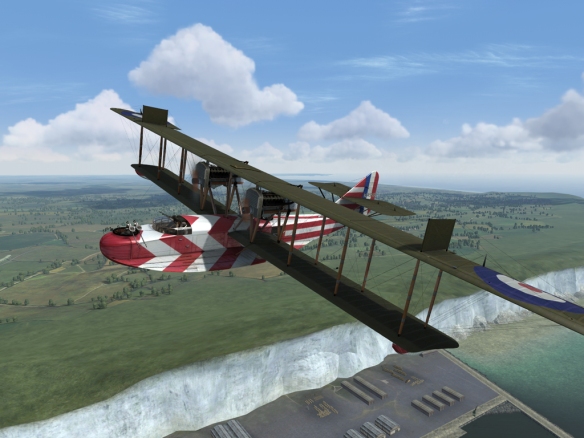The F.2A operated on anti-submarine patrol missions. Each plane could carry two 230 lb (104 kg) bombs under the lower wings. It was also defended by a machine gun position in the nose and three machine guns at mid-fuselage stations.
They were painted with dazzle schemes, not as an attempt at camouflage, but the exact opposite – to make them recognizable at a glance in the air and to be able to see a downed boat at sea. The first example of the benefit of this practice took place on June 4 1918, when three Felixstowe based boats and two from Great Yarmouth were involved in a fight with German seaplanes. One of the Yarmouth boats (either N4298 or N4289) was painted in red/yellow stripes and was the only one easily recognized of the five boats concerned. After this the others crews were allowed to paint their boats in similarly garish colours and patterns
#
The F2A was a British-American hybrid design and highly effective as a patrol craft. Its career closely paralleled the Short Sunderland of a later date and firmly established the reputation of flying boats as weapons.
Commander John C. Porte of the Royal Navy was a longtime advocate of flying boats for naval service. In 1914 he ventured to the United States at the behest of aircraft builder Glenn Curtiss to work on American designs. Following the onset of World War I he returned home, firmly convinced that England could benefit by such craft. However, as commander of the Felixstowe station, he found Curtiss H. 4s operating there unsatisfactory and set about modifying them. His subsequent F1 was found to be a better performer, so in 1917 he scaled up the new hull and fit it to the wings of a very large Curtiss H-12 Large America. The resulting hybrid was a superb aircraft for the time. It easily operated off the rough water conditions inherent in Northern Europe and, despite its bulk, was relatively maneuverable once airborne. This new craft was christened the Felixstowe F2A, and it arrived in the spring of 1917 just as Germany’s infamous U-boat campaign was peaking.
The Felixstowe flying boat acquired a well-earned reputation as the best flying-boat design of the war. Heavily armed with bombs and machine guns, it destroyed submarines and Zeppelins on several occasions. Moreover, it could readily defend itself against the numerous German floatplane fighters encountered over the North Sea. This fact was underscored on June 4, 1918, when four F2As beat off an attack by 14 Hansa-Brandenburg W. 29s, shooting down six with no loss to themselves. In an attempt to improve the Felixstowe’s performance, a new version, the F3, was developed. It featured longer wings and twice the bomb load but handled poorly and was never popular. The excellent F2As, meanwhile, remained on active duty for a decade following the war.
